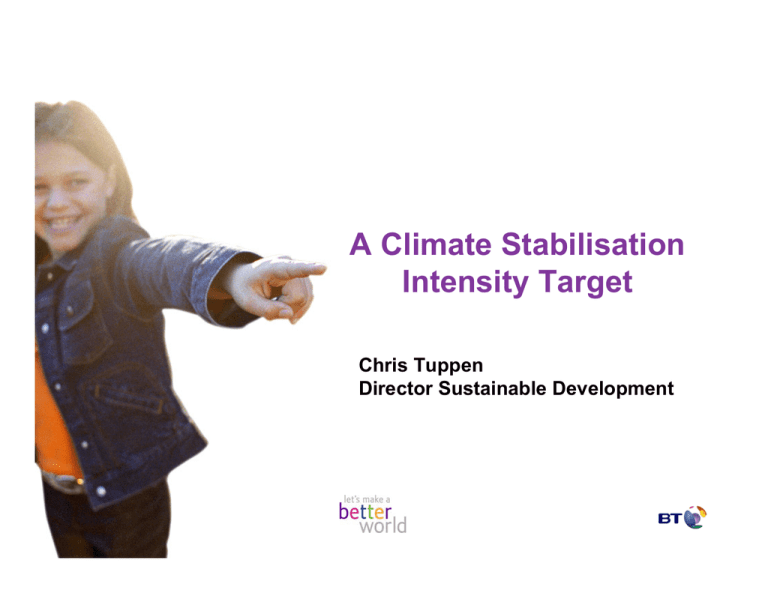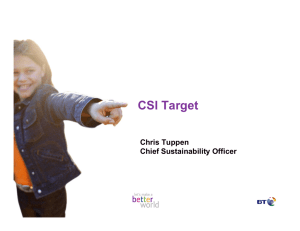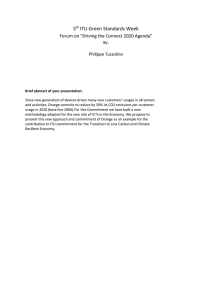A Climate Stabilisation Intensity Target Chris Tuppen Director Sustainable Development
advertisement

A Climate Stabilisation Intensity Target Chris Tuppen Director Sustainable Development ICT and Global CO2 Emissions ICT OPPORTUNITIES SMART BUILDINGS ICT Direct Footprint SMART GRIDS SMART LOGISTICS SMART MOTORS ICT Sector Direct Emissions Opportunity take up BAU growth 0.5 Gt 2008 X Gt The 2020 ICT challenge BAU efficiency 2020 This is a schematic representation only ? Gt 2020 Growth in Global CO2e Emissions 2008 47 Gtonnes CO2e 47,000,000,000 tonnes 1.67 Kg CO2e / £ GDP Diagram taken from the Stern Review 50% reduction on 1990 levels by 2050 80 CO2e (Gtonnes) 70 60 Absolute CO2 reduction target 50 40 30 20 10 0 1990 2000 2010 BAU (+1.2%pa) 2020 -2.1% 2030 -2.8% 2040 -4.4% 2050 -6.1% Average world GDP growth at constant prices (1980 to 2007) = 3.6% pa Decoupling of world CO2e emissions from economy (1990 to 2007) = 2.4% pa Net business as usual growth of world CO2e emissions = 1.2 % pa World CO2e intensity for 80% reduction in emissions 3.00 C O 2 e / u n it G D P ( K g /£ ) 2.50 Reducing at 9.6%pa at real prices 2.00 1.50 1.00 0.50 0.00 1990 2000 2010 2020 2030 2040 2050 But what should a company do? Diagram taken from the UNDP Human Development Report 2007/8 A company should ….. CO2e / unit GDP (Kg/£) 3.00 2.50 Reducing at 9.6%pa at real prices 2.00 1.50 1.00 0.50 0.00 1990 2000 2010 2020 2030 2040 2050 Match or exceed this trend – ie its CO2e per unit of contribution to GDP* should drop by at least 9.6% pa A company’s contribution to GDP is defined as its Value Added, where: Value Added = EBITDA + employee costs = turnover – bought in costs and services Adding in BT’s CO2e intensity ( CO2e Intensity = _____________ Value Added ) 3 Kg CO 2 e / £ 2.5 2 Reducing at 9.6%pa 1.5 1 0.5 BT 0 1990 2000 2010 2020 BT base line year 1996/7 2030 2040 2050 Setting a Climate Stabilisation Intensity Target 0.25 Kg CO 2 e / £ 0.2 0.15 0.1 80% reduction target by 2020 0.05 0 1990 2000 2010 2020 2030 2040 2050 2048 2045 2042 2039 2036 2033 2030 2027 2024 2021 2018 2015 2012 2009 2006 2003 2000 1997 CO2e (k tonnes) BT’s emissions are dropping in real terms 1,800 1,600 1,400 1,200 1,000 800 600 400 200 - Advantages of a CSI target • Combines company environmental and financial performance • Links company performance to global environmental and economic performance • Accommodates the normal dynamics of businesses such as organic growth, acquisitions and outsourcing • Provides a framework for modelling future strategy • Allows straightforward benchmarking Climate Stabilisation Intensity Target Ensures emission reductions are sufficient to prevent catastrophic climate change. Links climate protection to economic growth. Green growth for a low carbon future ICT Sector Direct Emissions Opportunity take up X Gt BAU growth 0.5 Gt 2008 The 2020 ICT challenge BAU efficiency 2020 ? Gt 2020 Bali Action Plan Decision 1/CP.13 ….. launch a comprehensive process to enable the full, effective and sustained implementation of the Convention through ….. Cooperative sectoral approaches and sector-specific actions http://unfccc.int/resource/docs/2007/cop13/eng/06a01.pdf An ICT Sector CSI Target? CO2 Value Added CSI Opportunity take up BAU growth The 2020 ICT challenge BAU efficiency 2008 2020 ICT Sector CSI target 2020 Renewable electricity is key • Build in-product and on-site renewable generation • Purchase renewable electricity • Lobby governments to create the right investment environment In Conclusion …… the ICT sector should: • Deliver climate friendly ICT solutions to our customers • Be ready for NGOs to challenge our direct footprint • Be prepared for an ICT sector obligation • Consider applying the CSI methodology to the sector • Push for more renewable electricity • Use our high tech creativity • Low carbon should be the standard Thank You www.bt.com/betterworld



